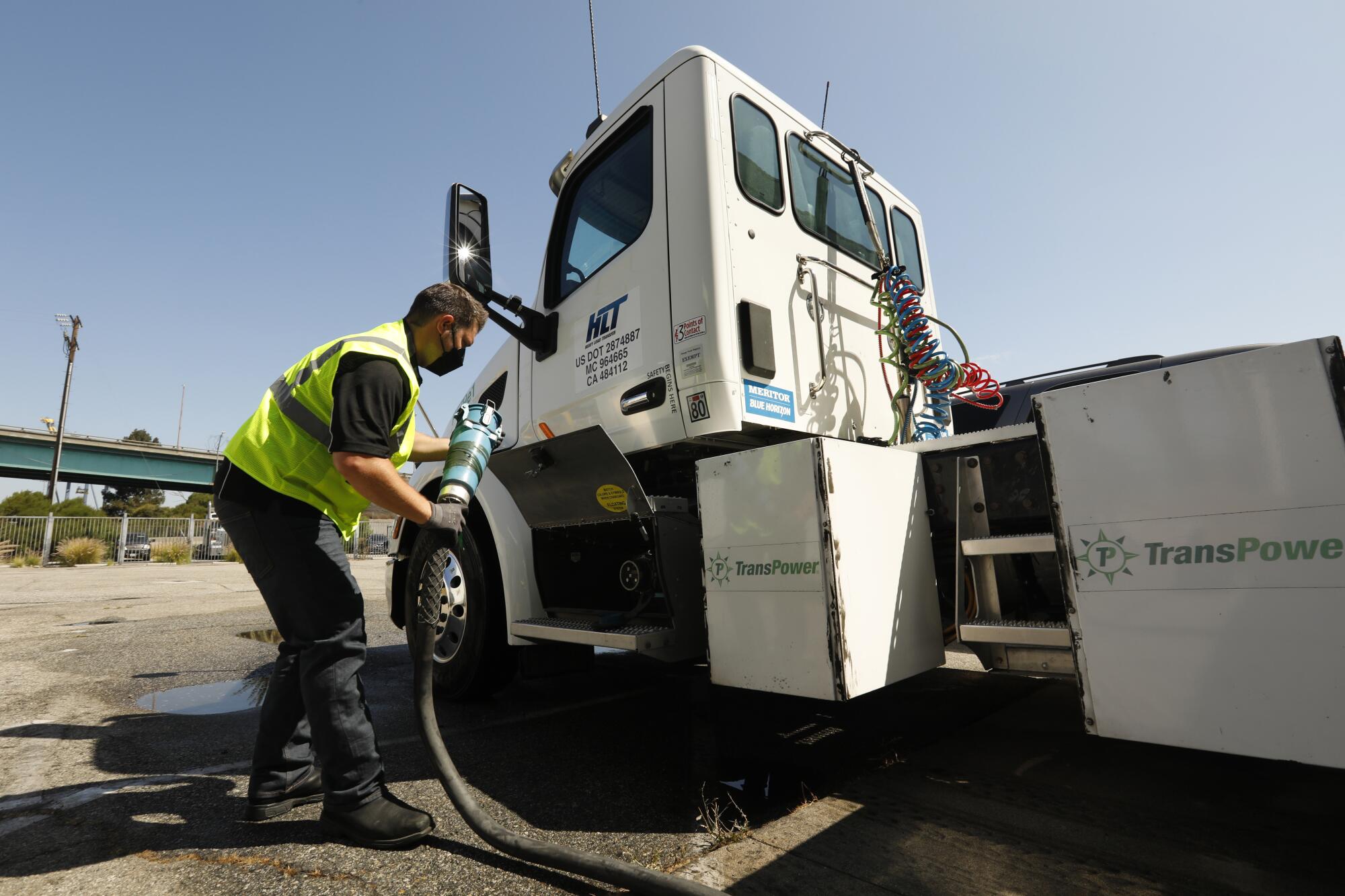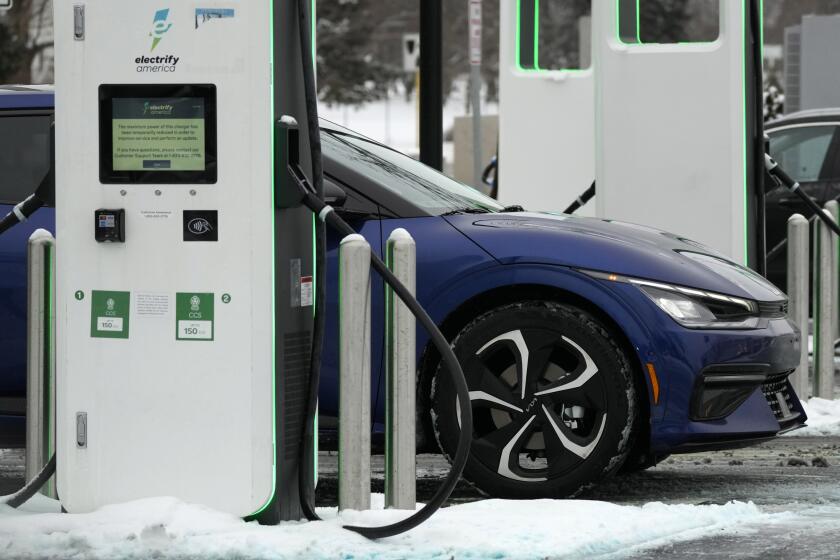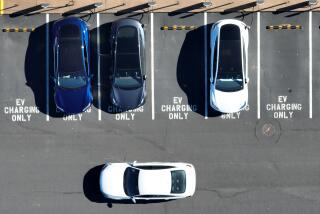
Fossil-fuel burning trucks spew alarming amounts of greenhouse gases, dangerous nitrogen oxides, lung-clogging particulate matter and a toxic stew of other pollutants.
Getting rid of them will be costly — nearly $1 trillion, according to an industry study released Tuesday.
Sponsored by the freight-hauling truck fleet industry, it concludes that charging infrastructure for a nationwide fleet of 100% electric trucks — from delivery trucks to big rigs — will cost $622 billion.
Add to that an additional $370 billion on electric utilities to upgrade or install electric substations, overhead and underground lines, transformers, poles and fixtures to supply truck chargers. Electricity providers “would need to spend nearly the equivalent of what was spent on the entire system during the past 15 years,” the report says, pegging the past cost at $450 billion.
Not covered in the report: the expense of the trucks themselves. Electric big rigs today cost hundreds of thousands of dollars each, or three to four times more than a diesel truck. California is spending billions in subsidies to make those trucks more affordable.
The motor freight industry says the highly detailed report adds to the concern that government mandates are moving too fast.
“It could put the supply chain at risk,” said Jim Mullen, chief strategy officer of the National Motor Freight Traffic Assn., a study sponsor. “It’ll make COVID look real tame if we don’t do this right.”
Industry alarmism? Hard to say, in part because policymakers have not produced such comprehensive dollar-cost studies of their own. A 2023 California Department of Transportation report estimates that building a charging network with 475 to 525 chargers to serve electric trucks on major highway corridors would cost $10 billion to $15 billion, not including electric upgrade costs.
The California Air Resources Board estimates that operating costs could be 22% to 33% lower for electric trucks than diesel or gasoline by 2030. (Generally, forecasts of future electric rates and fuel prices range widely depending on the source and the assumptions.)
“California and the federal government are making unprecedented investments to prepare for a zero-emissions future that will bring multiple cost-saving benefits in reduced fuel and maintenance costs for fleet operators,” said Steven Cliff, the air board’s executive officer. “Cleaner air will also mean reduced health costs for Californians, and a future with fewer costly impacts from climate change.”
State and federal officials have cited economic benefits of moving away from fossil fuel trucking: new jobs and industries created, reduction of climate risk, and, according to the air board, $26.5 billion in health-cost savings through 2050.
The climate and pollution problems are real, and carry enormous social, economic and health costs. But the dollar costs of minimizing those problems will be borne by taxpayers, utility ratepayers, truck makers, fleet owners, shippers and retailers, and will be reflected in the price of consumer goods.
Freight-hauling is a high-volume, low-margin endeavor. The cost of the transition matched with aggressive timelines imposed by government mandate could put enough freight-haulers out of business to disrupt freight traffic, the industry says.
The study was conducted by Roland Berger, an international consulting company based in Munich, Germany. The report fills a data vacuum on electric truck transition costs, said Wilfried Aulbur, senior partner at the firm. “We didn’t see a comprehensive, systemic study to look at what it means to decarbonize transportation sectors,” he said.
The industry is committed to cleaning up its vehicles, he said. “I don’t think anyone [involved in the study] is saying ‘let’s screw the next generation.’” But “we need to have a fact-based discussion around some of the limitations and some of the timelines involved.”
More than 6 million on-site chargers and about 175,000 on-route chargers would be needed nationwide, the report said, and it listed “hidden or unforeseen costs”: site-specific issues like the need for conduits and clearances; the scale and costs of wiring and electrical components; utility upgrades to handle the increased load; and backup solutions in case vehicles are unable to charge at a specific site.
California has assumed the national lead on decarbonizing transportation. Ten states have signed on to follow its regulatory lead in trucking. Under California mandate, by 2035, 100% of most two-axle trucks must be zero-emission; by 2039, big rigs with day cabs; by 2042, big rigs with sleeper cabs.
That mandate covers fleets with more than 50 vehicles or annual revenue over $50 million; state, local and federal government fleets; and trucks that haul freight in and out of seaports.
The most immediate concern of fleet operators: so-called drayage trucks that typically run shipping containers or bulk cargo back and forth from ports to rail yards and distribution centers, racking up a few dozen miles a day or so. (A small number travel hundreds of miles to their destinations.)
The state is cracking down on drayage trucks first. Last April, the air resources board ruled that no fossil fuel trucks purchased after Jan. 1, 2024, would be allowed to enter a seaport in California. Operators of fossil fuel trucks bought before that date can get into ports until those trucks reach 18 years of age or 800,000 miles, whichever comes first. By 2035, only zero-emission trucks will be allowed inside.
Despite complaints over the reliability of EV chargers, California regulators have approved Electrify America’s latest plan to expand charging infrastructure.
Drayage trucks were pinpointed for at least two reasons: Their noxious emissions disproportionately affect the health of people who live near seaports, who tend to live in low-income households. Also, because most drayage trucks travel short routes, there’s less need for high-powered truck chargers along the highway, easing the transition. The idea is that drayage trucks can use less powerful chargers at their home bases and fill up more cheaply at those slow chargers overnight.
Yet, few electric drayage trucks have been sold thus far, and a major build-out of charger systems at drayage depots or at the ports is required. Startups such as Forum Mobility, WattEV and Voltera Power, and established companies including Schneider Electric and ABN, are building or leasing charging stations for freight trucks.
There’s a long way to go to accommodate the state mandate, and heavy-duty truck fast chargers can cost more than $100,000 each.
The trucks themselves are enormously expensive, and for now anyway, hard to find and buy. A typical diesel truck costs about $120,000. In recent months manufactures of electric big rigs raised their prices to as much as $450,000 to $500,000. Even those are scarce — many buyers are on months-long waiting lists.
Drayage owners caught a break last December, when the air resources board announced it would delay enforcement of drayage rules until it receives permission from the U.S. Environmental Protection Agency to do so, under provisions of the federal Clean Air Act.
Meantime, the state faces a lawsuit filed by the California Trucking Assn. last year. It claims that federal law bars California from enforcing zero-emission truck mandates on vehicles registered outside the state that cross the border into California.
What are the truck fleets seeking? Among other things: Longer timelines to use biofuels in diesel engines that are in no way zero-emission, but do emit less pollution and fewer greenhouse gases than diesel trucks; rules that allow conversion of diesel engines to burn hydrogen fuel, which releases no greenhouse gas but does emit nitrogen oxide pollution, albeit far less than diesel fuel; a commitment to vehicle and charger subsidies; and a faster build-out of expensive utility substations needed to dispatch enough electricity to high-power truck chargers. Thus far, California regulators have drawn a firm stance on the timelines they’ve established.
Truck stop owners have concerns too. Lisa Mullings is chief executive at Natso, an industry group that represents truck stops and travel centers and is another study sponsor. She said Natso members are preparing for the energy transition but want more help from utilities in setting up microgrids — self-contained energy generators using solar or wind power that bypass the electric grid — so they can get more control over electricity prices.
“Travel centers have found business case impediments could be overcome if they could manage their own electricity [in a way] that didn’t require them to sell electricity to drivers at exorbitant costs just to break even,” Mullings said.
Nobody said the switch away from fossil fuels would be easy.
Toward a more sustainable California
Get Boiling Point, our newsletter exploring climate change, energy and the environment, and become part of the conversation — and the solution.
You may occasionally receive promotional content from the Los Angeles Times.








